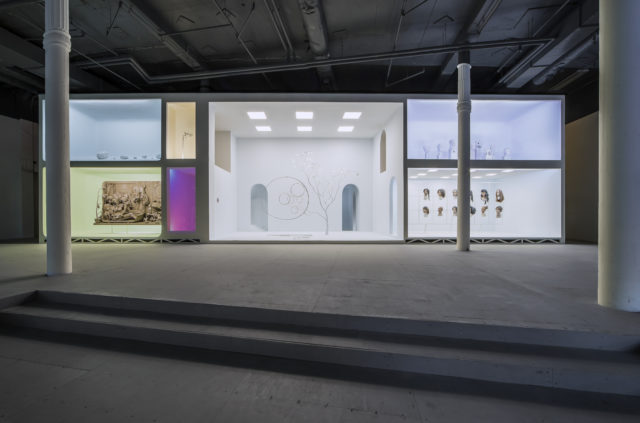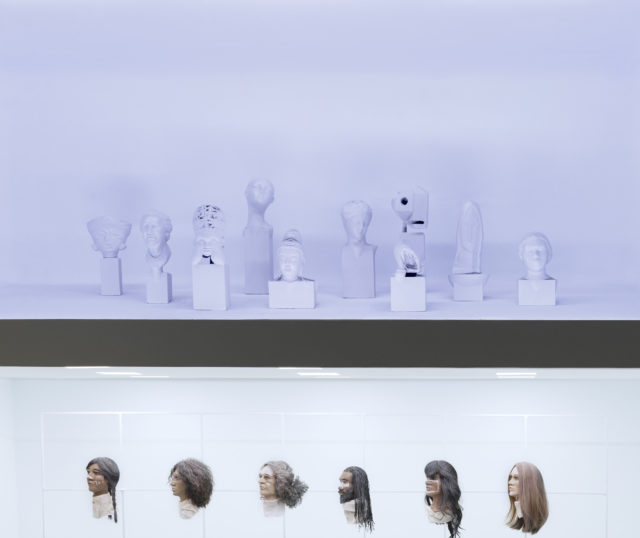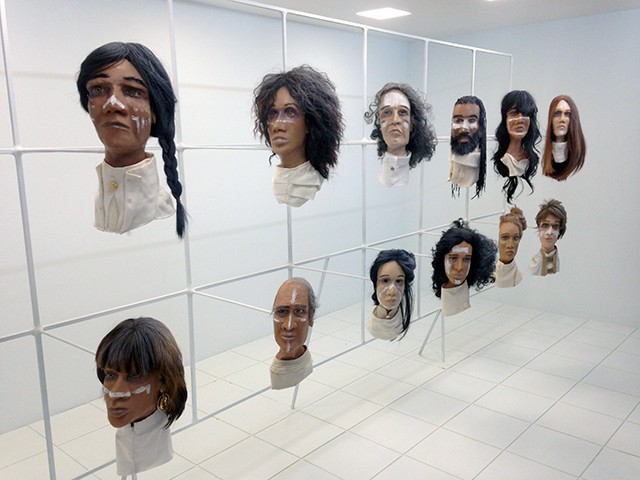Michael Jones McKean: The Ground
The Hutzler Brothers Palace Building
200 North Howard Street, Baltimore, MD
Presented by The Contemporary
Gallery hours: February 18 – May 19th (today!) 10 AM – 4 PM
Also on view during Black Ladies Brunch Collective Book Launch Saturday, May 20th and by appointment until May 31st.
Of all the strange art I’ve seen in my life, Michael Jones McKean’s brilliant installation The Ground is the only exhibition that’s given me an honest-to-god nightmare.
That’s surprising, considering the show is essentially a musing on the function and culture of display—in an inoffensive neutral palette—which at moments seems crafted with dry wit. Commissioned by Baltimore’s forever-mission-honing nomadic museum The Contemporary, it could be seen as the latest step in the institution’s attempt to work through some of those issues. Namely: how and why art gets displayed in what kinds of contexts.
The installation comprises one rectilinear white architectural form that bisects a large empty storefront at a slight diagonal. It’s divided into chambers, each containing a seemingly unrelated vignette. A central “atrium”, for example, houses a single, nearly-bare tree and abstract sculpture, all painted cool white. Other displays contain drawing-like sculptures, odd assortments of objects, or curious dioramas. Notably, there’s no didactic text accompanying any of the extremely-didactic-looking displays. One especially sparse cut-out holds hand-sculpted models of various mammal brains. Since they’re unlabelled, the human mind is anonymously lumped in alongside those of whales, cats, wolves, and elephants.
But the series doesn’t quite convey “body horror” per se—if anything, there’s a sense of humor sans the grotesque to much of the work. What’s uncanny, however, is the clinical sterility of the display—a dystopian human zoo that’s, on some level, about the absence of occupants. The creepiness of The Ground is felt almost immediately. Placing it takes some time.
The Ground is installed in one storefront of the sprawling former Hutzler’s department store in downtown Baltimore. It’s a curious, brooding building, parts of which date to 1880. When it opened then, it was described as “a museum of merchandise”, according to the exhibition text. Today, it houses only a massive internet server farm, processing roughly a quarter of the world’s data flows. Unlike so much of Baltimore, the old structure isn’t quite dilapidated, which makes it even more odd. It’s been maintained—just not for human occupation. McKean’s hyper-stylized architectural dioramas (which, by happy coincidence, share the otherworldly shopping-meets-set qualities of The Met’s Rei Kawakubo: Art of the In-Between exhibition design) present a similar paradigm.
It’s a life-sized dollhouse, full of objects that unabashedly show traces of the artist’s hand. Yet the structure itself is immaculate, clearly not built to be inhabited. The absence of bodies is palpably disturbing. In many tableaus, we catch glimpses of hidden corridors and behind-the-scenes access areas—they suggest a physical link between all of these ideas, but of course can’t be explored. The inutility of the space—despite ergonomic signifiers of human presence—is largely what makes it somewhat terrifying on a level I can’t fully explain. Knowing that a structure can’t be known in its entirety is unnerving on a primal level, similar to the architecture of the data networks that pulse elsewhere in the building. Or perhaps the mild panic that sets in when I imagine collecting museums’ vast hidden storerooms and archives—the mysterious infrastructures that govern what we see and how.
McKean seems to probe that logic of what curators place on view (and into the canon). One of the spotless white cubes holds reproductions of busts throughout art history—from an Olmec-looking head beside Michaelangelo’s “David” to Siddhartha and what I’m assuming is a cubist representation of a face. All are reproduced at the same roughly life-sized scale in matte white.
Below the monochrome world history of representation, a grid of twelve hand-sculpted, full-color human heads floats awkwardly in a void. The specimens span multiple races and genders, and many are demographically ambiguous, suggesting a community of choice. That’s an impression reinforced by their styling—all have different cult-like collars in off-white and face paint that’s somewhere between tribal markings and CV Dazzle. Are these the hunting trophies of an alien conqueror? Practice heads for a strange aesthetician school? An anthropology display from a dystopian future? An obscure nook of the not-so-distant past? Present? Is it worth noting that all but two of them have vaguely concerned expressions on their face?
These are but a handful of the questions raised by each component of McKean’s installation, which is deceptively sparse but jam-packed with content. Which of these details are important and what does it all mean? For an artwork that seems to be about the limits of sculpture, display, or “the collection” as a didactic or narrative tool, the answer to that question could be everything and nothing.
Although the site-specific installation certainly references the vocabulary of retail displays (wig heads, storefronts, IKEA model rooms) it’s impossible to consider McKean’s work independent of the context of the institution which commissioned it. Since The Contemporary (formerly the Contemporary Museum) rebooted itself as a nomadic presenting/granting organization under the leadership of Deana Haggag in 2013, much of their programming has felt like an investigation of what the utility of “a museum” is. The institution has redefined itself by diving unabashedly into its own identity crisis—through diverse artist-centric programing alongside exhibitions and publications that can read as critical institutional self-examination. Much like the Hutzler’s building, The Contemporary now largely serves as a platform for the exchange of information rather than the display of objects of desire. Haggag is about to step down as director, heading to lead granting organization United States Artists, and The Ground feels like the tentative capstone of this brief but transformative era in the museum’s history.
This is a lot of backstory but it’s necessary, perhaps, for understanding the curatorial logic behind an exhibition about curatorial logic—or lack thereof. The last major Contemporary commission was a sprawling installation from Abigail DeVille in the Peale Museum, the Western Hemisphere’s oldest purpose-built museum building, which had sat vacant for years. If that installation embraced chaos to investigate the storytelling potential of museums/objects, the McKean show could be read as a startlingly sterile bookend—turning a black mirror on polished institutional aesthetics. The rhetorical questions about museum-ness posed by these projects feel less like self-indulgent curatorial navel-gazing and more like a fruitful laboratory experiment between institution, artist, and public. (The Contemporary, in a past incarnation, also commissioned Fred Wilson’s seminal Mining the Museum at the Maryland Historical Society a few blocks away in 1993. It’s since become required reading in the world of curation and museum studies.)
Rounding a corner to the side of McKean’s installation, it’s almost easy to overlook one of the show’s most loaded (literally) prompts for thinking about the nature of a collection. A small barely-lit case is embedded in the wall. It recalls the kind of climate-controlled racks data servers are stored in, but on closer inspection is jam-packed with hundreds of small plastic discs containing mysterious specimens (I later picked up an inventory list of what they were: meteorite fragments, seeds, and myriad other objects of interest). If the museum’s origins lie in the Enlightenment-era wunderkammer, this might point to a modern cousin: archives of obsessive preservation. How many of these species will cease to exist outside of university labs or government seed banks within our lifetimes? The expanse of time implied by ancient space rocks and impending ecological disasters is overwhelming.
The rear side of the display holds a fake-plant-filled grotto like one might see in a natural history museum’s anthropology diorama (arguably the most problematic and loaded genre of curatorial display, on account of its colonial and racist history). Here, though, no “primitive” humans inhabit the cave, only a single bouquet of flowers humorously/creepily placed in the darkest nook. A line of perspectivally-compressed representations of organic and man-made objects—from a horseshoe crab and avocado to roller luggage and an iMac—floats in a non-space above. Like the busts on the other side of the installation, they’re all white, as if they had been fabricated by the 3D printers of Westworld. They feel like props ready to be dropped in to some reenactment of life on a long-dead Earth.
The sci-fi horror of absent bodies is perhaps driven home most directly by the twin displays at the opposite end of the diorama, connected to the “prop” room by a futuristic catwalk. In one flesh-colored chamber, a lumpy frame holds samples of Band-aids in various skin tones—surrogate skin like Pantone swatches of humanity. The frame is mirrored in the chamber above (with the negative space inverted), a minimalist “human habitat” from the present day or not-so-distant future.
The immediacy of The Ground’s allusions and seemingly-unrelated sense of dread is complimented by the slow burn of trying to connect the two (and a subtle, dark sense of humor). In the face of mortality, humanity has always found some small comfort in the idea of legacy. It’s why the powerful of yesteryear commissioned grand buildings with storytelling mosaics or stained glass windows and why contemporary oligarchs bequeath their collections to museums. But knowing how much archeologists, historians, and curators have gotten wrong (or just guessed) when discussing artifacts from the past, how much faith can we place in these professions’ ability to represent us in the future? There is, of course, more to The Ground than that concern. But it’s an inescapable question the more likely societal collapse and extinction-level events seem to become with each passing day—all while we heap ever more useless objects, extraneous data, and tangled history on the archivist’s pile.
Michael Jones McKean | The Ground from theuniformbridgetheory on Vimeo.
One of the few works in the show without a trace of dystopic anxiety, however, is also a bit of an aesthetic outlier (the first detail shot in the video above). A clay bas-relief that seems to sample styles from Mayan, archaic Hindu, and Gothic religious architectural details brought a much-needed chuckle. It depicts a home water birth in a bathtub, with a Madonna figure surrounded by a supportive audience of characters who appear to be plucked from various mythologies (two hooded priest-like figures are blowing kisses). Also in attendance are a collection of trendy houseplants and a cat, who looks slightly confused/disturbed by the ritual it’s witnessing. The sculpture is endearingly human and goofy, very much of the Pinterest era but also timeless. It’s a shame the clay doesn’t appear to be fired, because this would be a perfectly acceptable last trace of humanity left for an alien archaeologist.





Comments on this entry are closed.
{ 1 trackback }